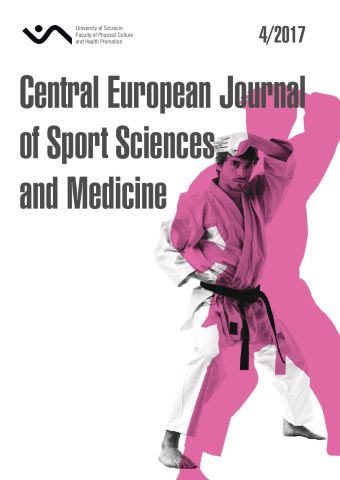
ISSN: 2300-9705
eISSN: 2353-2807
OAI
DOI: 10.18276/cej.2017.4-10




Lista wydań /
Vol. 20, No. 4/2017
Changes in Motor Skills of Children who Train Sports Swimming at the Initial Stage of School Education (in an Annual Training Cycle)
| Autorzy: |
Paweł
Eider
Faculty of Physical Culture and Health Promotion, University of Szczecin, Szczecin, Poland Krzysztof Wilk Faculty of Physical Culture and Health Promotion, University of Szczecin, Szczecin, Poland Michał Tarnowski Faculty of Physical Culture and Health Promotion, University of Szczecin, Szczecin, Poland Robert Terczyński Faculty of Physical Culture and Health Promotion, University of Szczecin, Szczecin, Poland |
| Słowa kluczowe: | selection motor skills swimming girls analysis |
| Data publikacji całości: | 2017 |
| Liczba stron: | 13 (93-105) |
Abstrakt
This paper presents an empirical approach to the changes in motor skills of children who train sports swimming at the initial stage of school education in an annual training cycle. Swimming belongs to the disciplines in which training starts at the age of 6-7. The proper selection of candidates to train certain disciplines is a complex process as they should be chosen from a large population of children, both girls and boys, having specific somatic and motor characteristics which, developed in the long-term, will enable them to achieve sports mastery.
The aim of the research was to define which changes in motor skills occur in girls who train sports Aim: swimming in an annual training cycle.
The Subject group consisted of 85 girls aged 7 who attended four elementary schools in Szczecin, Poland. 36 of them belonged to the Swimmers group and they were all members of the Municipal Swimming Club (MKP) in Szczecin. The Control group consisted of 49 girls who attended the same elementary schools. All subjects took part in two examinations (carried out in the school year 2009/2010. Physical ability tests were conducted in gyms. Motor skills were assessed with EUROFIT Test Battery which is the most reliable and accurate tool according to scientific research. The research revealed changes in both groups (Sw, C) in terms of all eight tests. Examination II proved statistically significant improvement of results in both groups (Sw, C) in comparison to Examination I. Changes between Examination I and Examination II results were most visible in the Swimmers groups in terms of balance, agility, static strength, functional strength and agility run. Changes between Examination I and Examination II were similar in both groups (Sw, C) in terms of speed of limb movement, explosive strength and torso strength. Progressive changes in motor skill of subjects are a positive phenomenon in the physical development of a child.
Swimming training resulted significantly in positive changes in terms of motor skills of subject who were at the initial stage of swimming trainings, compared to their non-training peers. Participation in organized, regular sports classes results in the development of motor (physical) skills of children.
Pobierz plik
Plik artykułu
Bibliografia
| 1. | Chalcarz, W., Merkiel, S., Pach, D., Lasak, Ż. (2008). Charakterystyka aktywności fizycznej poznańskich dzieci w wieku szkolnym. Medycyna Sportowa, 5 (24), 318–329. |
| 2. | Chomiak, J, Migasiewicz, J. (1998). Organizacja doboru i szkolenia dzieci uczęszczających do szkoły o profilu sportowym. In: P. Kowlaski, J. Migasiewicz (eds.), Sport pływacki i lekkoatletyczny w szkole (pp. 409–415) (Wrocław–Srebrna Góra 1996, 1997). Wrocław: AWF. |
| 3. | Cięszczyk, P. (2005). Próba kompleksowej oceny doboru do sportu na przykładzie zespołowych gier sportowych. Antropomotoryka, 32, 59–71. |
| 4. | Cięszczyk, P. (2008). Efektywność przygotowania sprawnościowego na wstępnym etapie szkolenia, jako przesłanki racjonalizacji procesu treningowego w klasach sportowych o profilu zespołowych gier sportowych. International Association of Ontokinesiologist. Szczecin. |
| 5. | Eider, P. (2014). Selection in swimming training- theoretical study. No. 1 in Szczecin. Centr Eur J Sport Sci., 1 (5), 65–75. |
| 6. | Denisiuk, L., Milicerowa, H. (1969). Rozwój sprawności motorycznej dzieci i młodzieży w wieku szkolnym. Warszawa: PZWS. |
| 7. | Dziedziczak, K., Witkowski, M. (1998). Rozwój fizyczny i sprawność fizyczna dzieci uprawiających pływanie. Wychowanie Fizyczne i Sport, 4, 13–20. |
| 8. | Grabowski, H., Szopa, J. (1991). EUROFIT. Europejski Test Sprawności Fizycznej. Kraków: AWF. |
| 9. | Karpiński, R., Opyrchał, C. (2008). Pływanie na Igrzyskach Olimpijskich w Pekinie – analiza poziomu sportowego, wieku i budowy somatycznej pływaków. Sport Wyczynowy, 10–12, 7–23. |
| 10. | Kolbowicz, M. (2012). Efektywność specjalnego przygotowania fizycznego w wieloletnim procesie szkolenia sportowego wioślarzy kadry olimpijskiej. Doctoral thesis typescript. Poznań: AWF. |
| 11. | Kosmol, A. (1997). Pływanie na Igrzyskach w Atlancie i Barcelonie. Sport Wyczynowy, 7–8, 9–24. |
| 12. | Opyrchał, C., Karpiński, R., Sachnowski, K. (2005). Proces wieloletniego szkolenia pływaków wysokiej klasy. Sport Wyczynowy, 9–10, 57–67. |
| 13. | Osiński, W. (2011). Teoria wychowania fizycznego. Poznań: AWF. |
| 14. | Pietrusik, K. (1981). Kształtowanie się sprawności motorycznej oraz wydolności fizycznej u dzieci uprawiających pływanie sportowe. Roczniki Naukowe AWF, 30, 107–125. |
| 15. | Przewęda, R. (1981). Rozwój somatyczny i motoryczny. Warszawa: WSiP. |
| 16. | Socha, S. (2008). Lekkoatletyka i pływanie na Igrzyskach Olimpijskich w Pekinie. Sport Wyczynowy, 10–12, 24–34. |
| 17. | Szopa, J., Chwała, W., Rychlewicz, T. (1998). Badania struktury zdolności motorycznych o podłożu energetycznym i trafność ich testowania. Antropomotoryka, 17, 3–41. |
| 18. | Torrance, B., McGuire, KA., Lewanczuk, R., McGavock, J. (2007). Overweight, physical activity and high blood pressure in children: a review literature. Vasc Health Risk Manag, 1 (3), 139–149. |
| 19. | Wilk K., Eider P. (2014) The evaluation of motor skills of 1–4 grade music-oriented male students in Primary School Complex. No. 2 in Szczecin. Centr Eur J Sport Sci., 2 (6), 35–58. |